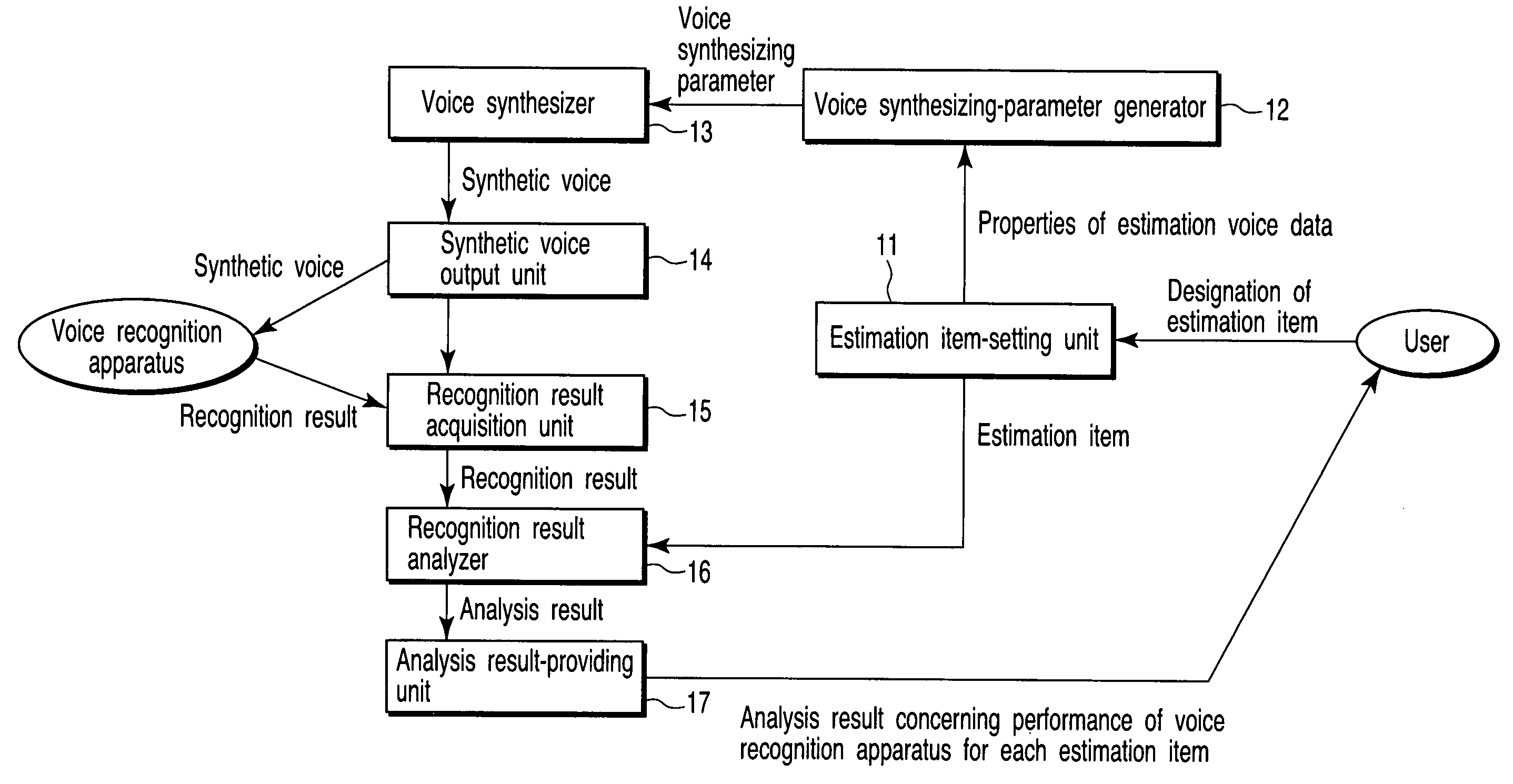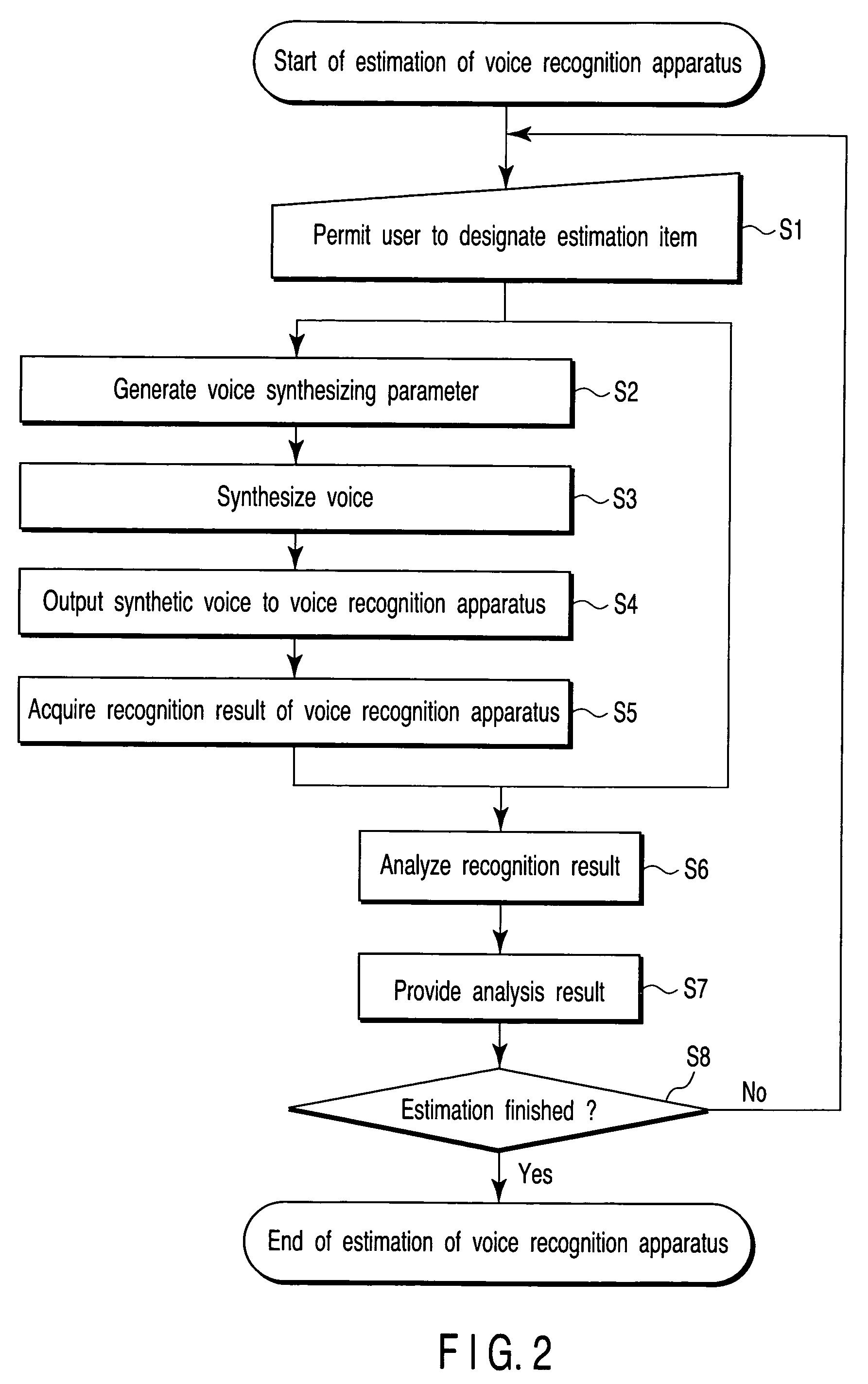Voice recognition performance estimation apparatus, method and program allowing insertion of an unnecessary word
a voice recognition and performance estimation technology, applied in the field of apparatus, method and program for estimating the performance of a voice recognition apparatus, can solve the problems of requiring a large amount of voice data to be used as estimation voice data sets, requiring additional time and expense, and requiring a large amount of voice data to be recorded, so as to achieve the effect of not requiring a lot of time and expense for voice data estimation and easy estimation of the performance of each estimation item
- Summary
- Abstract
- Description
- Claims
- Application Information
AI Technical Summary
Benefits of technology
Problems solved by technology
Method used
Image
Examples
first embodiment
[0039]Referring to FIG. 1, each unit of a voice recognition estimating apparatus according to a first embodiment will be described. FIG. 1 is a block diagram illustrating this estimating apparatus.
[0040]An estimation item-setting unit 11 permits a user to designate an estimation item for a voice recognition apparatus. Estimation items are used to determine whether the voice recognition apparatus can discriminate different types of voice input thereto. The estimation items include, for example, voice quality data, vocabulary data, data indicating whether or not a hesitation pause, hesitation voice or unnecessary word is inserted, and data indicating the emotion with which a voice is charged. The voice quality data includes, for example, the sex of a speaker, the speed of speech, voice tone and intonation. In the first embodiment, three estimation items—the sex of a speaker, the speed of speech and the tone of voice—are used as properties of estimation voice data. Vocabulary data will...
second embodiment
[0067]A voice recognition estimating apparatus according to a second embodiment differs from the apparatus of the first embodiment only in that the former further employs a voice characteristic vector synthesizer 23 and characteristic vector output unit 24. FIG. 7 is a block diagram illustrating the voice recognition estimating apparatus of the second embodiment.
[0068]In the voice recognition estimating apparatus of the second embodiment, the voice characteristic vector synthesizer 23 outputs, instead of synthetic voice, characteristic vector time-series data that can be input to a to-be-estimated voice recognition apparatus. The characteristic vector time-series data is, for example, LPC cepstrum (characteristic amount). Concerning LPC cepstrum, see, for example, “Voice Data Processing” by Furui, published by Morikita Publishers Co., Ltd. The voice characteristic vector synthesizer 23 outputs the characteristic vector time-series data to the characteristic vector output unit 24. Th...
third embodiment
[0070]A voice recognition estimating apparatus according to a third embodiment differs from the first and second embodiments in that the former employs “Grammar” as an estimation item designated by a user. In this embodiment, the user designates estimation item “Grammar” to estimate a to-be-estimated voice recognition apparatus. Since thus, the designated estimation item differs from those of the first embodiment, the third embodiment differs from the first embodiment only in the estimation item-setting unit and recognition result analyzer. The other structural elements are similar between the first and third embodiments. FIG. 8 is a block diagram illustrating the voice recognition estimating apparatus of the third embodiment.
[0071]An estimation item-setting unit 31 permits a user to designate the estimation item “Grammar that can be input to a voice recognition apparatus”. In this case, assume that the estimation item “Grammar” is formed of two words—“Power-on” and “Power-off”. The...
PUM
 Login to View More
Login to View More Abstract
Description
Claims
Application Information
 Login to View More
Login to View More - R&D
- Intellectual Property
- Life Sciences
- Materials
- Tech Scout
- Unparalleled Data Quality
- Higher Quality Content
- 60% Fewer Hallucinations
Browse by: Latest US Patents, China's latest patents, Technical Efficacy Thesaurus, Application Domain, Technology Topic, Popular Technical Reports.
© 2025 PatSnap. All rights reserved.Legal|Privacy policy|Modern Slavery Act Transparency Statement|Sitemap|About US| Contact US: help@patsnap.com



